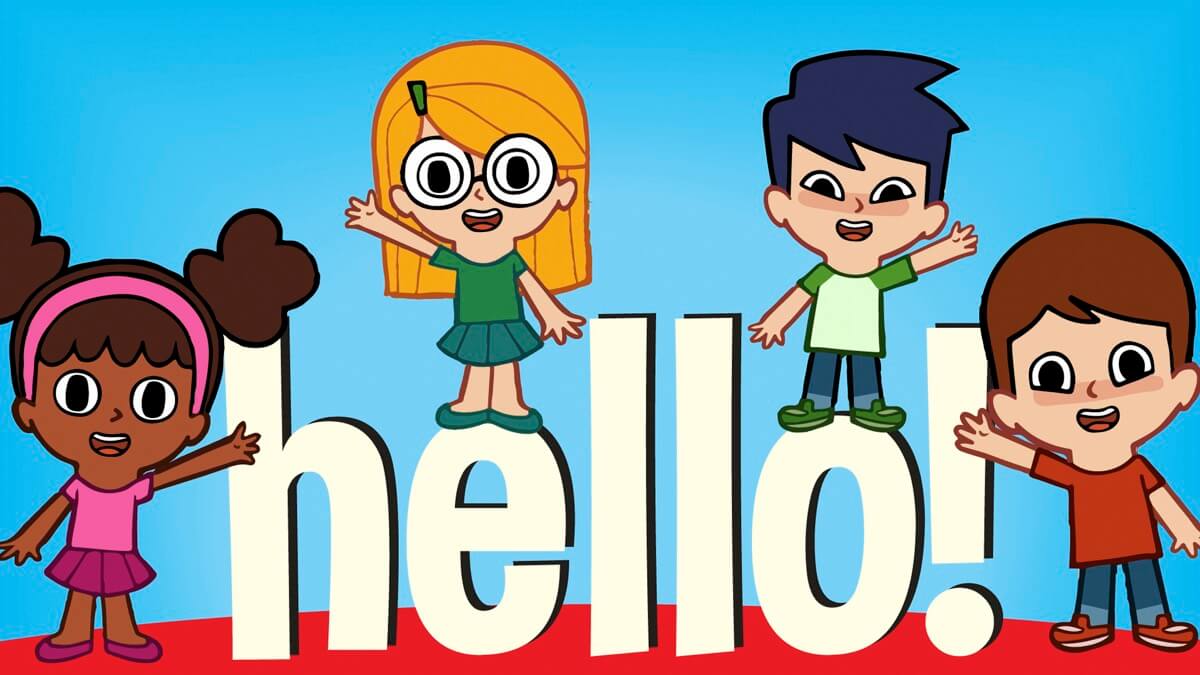Mastering 'Hello In French': Your Essential Guide To Greetings
Table of Contents
- The Universal Greeting: Bonjour
- The Casual Alternative: Salut
- Navigating Formality: Choosing the Right Hello
- Beyond the Basics: Other French Greetings
- Regional Flavors: Hello in Cajun French
- Cultural Context: The Importance of Greeting
- Common Mistakes to Avoid
- Mastering Your French Hello: Practice Makes Perfect
The Universal Greeting: Bonjour
When you ask, "What does hello mean in French?", the immediate and most common answer you'll receive is *bonjour*. This word is the cornerstone of French greetings, universally understood and appropriate in nearly all situations. It is the go-to phrase for saying hello in French, regardless of whether you're addressing a stranger, a shopkeeper, or a colleague.Meaning and Usage
The word *bonjour* literally translates to "good day." This direct translation highlights its versatility and politeness. It's a formal way to say hi or hello in France, suitable for the vast majority of social interactions. You can use *bonjour* from morning until late afternoon, even early evening, as long as it's still daylight. It conveys a sense of respect and acknowledgement, making it indispensable for any visitor or learner of French. For instance, when you walk into a bakery, you would say *bonjour* to the baker. When you enter a waiting room, a polite *bonjour* to others present is customary. It's not just a greeting; it's an acknowledgement of shared space and a polite opening to any interaction. The importance of using *bonjour* cannot be overstated in French culture; failing to greet someone can be perceived as rude or dismissive.Pronunciation Tips
Pronouncing *bonjour* correctly is key to sounding natural. It's pronounced "bohn-ZHOOR." * The "bon" part rhymes roughly with the "bon" in "bonbon" or the "on" in "long" (nasal 'o' sound). * The "jour" part is pronounced like the "jour" in "journal," with a soft 'j' sound similar to the 's' in "measure" or 'g' in "beige," followed by a rolled 'r' sound (though many native speakers don't roll it heavily). Practicing this pronunciation will help you sound more authentic when you say hello in French. Listening to native speakers and mimicking their intonation is highly recommended. Online resources like Forvo or Google Translate's audio feature can be invaluable for refining your pronunciation.The Casual Alternative: Salut
While *bonjour* is the default, there's another very common way to say hello in French, especially among friends, family, and peers: *salut*. This word is the equivalent of "hi" in English and is slightly less formal than *bonjour*.When to Use Salut
*Salut* is to say hi. It's perfect for informal settings and people you know well. You wouldn't typically use *salut* when meeting someone for the first time, especially in a professional or formal context. It's reserved for friends, classmates, siblings, or people of a similar age and social standing with whom you have an established casual relationship. For example, if you bump into a friend on the street, a simple *salut* is perfectly appropriate. If you're texting a friend, *salut* is also the common choice. It implies a level of familiarity and comfort that *bonjour* does not. Using *salut* with someone you don't know well or in a formal situation can come across as impolite or presumptuous.Pronunciation Nuances
*Salut* is pronounced "sah-LOO." A crucial detail here is that you do not pronounce the 't' at the end. This silent 't' is a common feature in French pronunciation and mastering it will significantly improve your spoken French. The "salu" part rhymes with "aloo" (as in "aloo gobi"). Just like with *bonjour*, listening to native speakers will help you internalize the correct sound and rhythm.Navigating Formality: Choosing the Right Hello
The choice between *bonjour* and *salut* hinges entirely on the level of formality required by the situation and your relationship with the person you're addressing. Understanding this distinction is crucial for effective and polite communication in French. It's not just about saying hello in French; it's about saying it appropriately.Addressing Professionals and Elders
When interacting with teachers, doctors, shopkeepers, or anyone in a position of authority or respect, *bonjour* is always the correct choice. Furthermore, it is important to use the appropriate title. In French, you would greet a teacher by saying *bonjour, monsieur/madame* (hello, sir/ma'am) or *bonjour, professeur* (hello, teacher). This shows deference and politeness. Similarly, when addressing an elder, even if you know them, starting with *bonjour* is often preferred, unless you have a very close, informal relationship where *salut* has been established. This adherence to formal greetings underscores the respect for hierarchy and age prevalent in French culture.Phone Etiquette: Allô
Interestingly, there's a specific way the French say hello when they answer the phone: *allô*. While it sounds identical to the English "hello" on the phone, its usage is quite specific. You wouldn't typically use *allô* as a face-to-face greeting. It's almost exclusively reserved for answering a phone call or, occasionally, to get someone's attention if they are not responding (e.g., "Allô? Est-ce que tu m'entends?"). So, if your phone rings and you want to say hello in French, *allô* is the word you're looking for. This specialized usage highlights how context dictates the appropriate greeting.Beyond the Basics: Other French Greetings
While *bonjour* and *salut* cover most "hello in French" scenarios, the French language offers other greetings that convey specific times of day or levels of formality. These phrases add depth to your conversational repertoire. * **Bonsoir (Good Evening):** As the day transitions into evening, *bonjour* gives way to *bonsoir*. This is used from late afternoon onwards, typically when the sun starts to set. It serves as both a "good evening" and a "hello" during the evening hours. For example, if you enter a restaurant at 7 PM, you would say *bonsoir* to the host. * **Bonne nuit (Good Night):** This is generally used as a farewell when someone is going to bed, not as a general greeting upon arrival in the evening. * **Ça va? (How are you?):** This is a very common follow-up question after *bonjour* or *salut*. It literally means "It goes?" and is a casual way to ask "How are you?". The typical response is *Ça va bien, merci* (It's going well, thank you) or simply *Ça va* (It's going well). This phrase is essential for extending a greeting into a brief conversation. * **Enchanté(e) (Pleased to meet you):** While not a direct "hello," *enchanté* is often used immediately after a greeting when meeting someone new. It means "enchanted" or "delighted" and is a polite way to express pleasure at the introduction. Remember to add an 'e' at the end if you are female (*enchantée*). It's also worth briefly touching upon farewells, as they are the natural counterpart to greetings. The traditional French equivalents of 'goodbye' are *adieu* and *au revoir*. The word *adieu*, which means 'to God', tends to be more final and formal, often implying a permanent or very long separation. The word *au revoir* means 'until we see each other again' and is the standard, more common way to say goodbye in most situations, implying a future meeting.Regional Flavors: Hello in Cajun French
French is not confined to France; it's spoken in many parts of the world, and some regions have developed unique dialects and variations. One such fascinating variant is Cajun French, spoken in Louisiana and Alabama along the Gulf Coast of the United States. While standard French is widely understood, exploring regional greetings adds a rich layer to your understanding of the language. It's important to clarify a common misconception: there's actually no such language as "French Creole." The word "Creole" refers to a type of language that results from the combination of two completely different parent languages, often developing in colonial contexts. While Louisiana does have Louisiana Creole (a distinct language), Cajun French is a dialect of French, influenced by English and other languages, but still fundamentally French. In Cajun French, the word 'hello' is said as *bonjou*. While it looks similar to standard French *bonjour*, the pronunciation and context might differ slightly. It retains the essence of "good day" but with a distinct regional flavor. Beyond *bonjou*, Cajun French offers other unique expressions. For instance, to ask "how are you?" in Cajun French, you would say *Ça va?* – similar to standard French, but often with a distinct intonation. To say "it is good" in Cajun French, you can say *C'est bon*. These examples show how a core French phrase can evolve and adapt within a specific cultural context, making the study of "hello in French" even more diverse.Cultural Context: The Importance of Greeting
In French-speaking cultures, the act of greeting is far more significant than in many English-speaking countries. It's not just a polite formality; it's a social ritual that establishes respect, acknowledges presence, and opens the door for interaction. Neglecting to greet someone, even a stranger you pass in a hallway or a shop assistant, can be considered rude or dismissive. This is a crucial aspect to grasp when learning how to say hello in French. * **Non-Verbal Cues:** Beyond the spoken word, non-verbal cues play a vital role. When greeting someone formally, a firm handshake is common. Among friends and family, *la bise* (a kiss on each cheek, the number varying by region) is customary. Maintaining eye contact while greeting is also a sign of sincerity and respect. * **Greeting Multiple People:** If you enter a room with several people, it's customary to greet each person individually with *bonjour* (or *salut* if appropriate) and a handshake or *la bise*. A general "Bonjour tout le monde" (Hello everyone) might be acceptable in very casual group settings, but individual greetings are preferred, especially in formal or smaller gatherings. * **Entering and Exiting:** Always greet when entering a shop, restaurant, or even a doctor's waiting room. Similarly, always say goodbye (*au revoir*) when leaving. This constant exchange of greetings and farewells is a cornerstone of French social etiquette. Understanding these cultural nuances elevates your ability to say hello in French from mere translation to truly effective communication. It shows respect for the culture and fosters positive interactions.Common Mistakes to Avoid
Even with the best intentions, learners often make a few common errors when trying to say hello in French. Being aware of these can help you avoid awkward situations and communicate more effectively. 1. **Using *Salut* in Formal Situations:** This is perhaps the most frequent mistake. Remember, *salut* is strictly for informal contexts. Using it with a stranger, a shopkeeper, or an elder can be perceived as disrespectful. Always default to *bonjour* if you're unsure. 2. **Forgetting to Greet:** As discussed, not greeting someone at all is a significant faux pas in French culture. Make it a habit to say *bonjour* (or *bonsoir*) upon entering any establishment or interacting with anyone. 3. **Mispronouncing Key Sounds:** French has several sounds that don't exist in English (like the nasal vowels or the 'r' sound). While perfection takes time, making an effort to correctly pronounce *bonjour* ("bohn-ZHOOR") and *salut* ("sah-LOO" without the 't') will greatly improve your intelligibility and confidence. 4. **Using *Allô* for Face-to-Face Greetings:** Remember, *allô* is primarily for phone calls. Do not use it when greeting someone in person. 5. **Using *Adieu* Casually:** *Adieu* is a very strong and final goodbye. Unless you genuinely mean "farewell forever," stick to *au revoir*. Using *adieu* casually can sound overly dramatic or even imply you don't expect to see the person again. By being mindful of these common pitfalls, you can enhance your ability to say hello in French confidently and appropriately.Mastering Your French Hello: Practice Makes Perfect
Like any aspect of language learning, mastering how to say hello in French requires practice and immersion. Simply knowing the words isn't enough; you need to internalize their usage, context, and cultural implications. * **Listen Actively:** Pay attention to how native French speakers greet each other in films, TV shows, podcasts, or online videos. Notice the intonation, the body language, and the specific words they choose based on the situation. * **Practice Out Loud:** Don't just read the words; say them. Practice *bonjour*, *salut*, *bonsoir*, and *allô* repeatedly until they feel natural on your tongue. Record yourself and compare it to native speakers. * **Engage with Native Speakers:** If possible, find opportunities to speak with native French speakers. This could be through language exchange partners, online communities, or local French clubs. Real-life interactions are the best way to solidify your understanding and gain confidence. Even a simple "Bonjour!" to a French-speaking person you encounter can be a valuable practice. * **Utilize Language Learning Apps:** Many apps offer pronunciation exercises and conversational scenarios that can help you practice your greetings in a structured way. * **Visit French-Speaking Regions:** The ultimate test and learning experience is to immerse yourself in a French-speaking environment. From France itself to Quebec, Belgium, Switzerland, or even parts of Louisiana, you'll find ample opportunities to put your "hello in French" skills to the test. Remember, every time you successfully greet someone in French, you're not just saying a word; you're building a connection, showing respect, and furthering your journey in language acquisition.Conclusion
Learning how to say hello in French is much more than memorizing a single word; it's about understanding a rich tapestry of cultural norms, levels of formality, and regional variations. We've explored the universal *bonjour*, the casual *salut*, the phone-specific *allô*, and even delved into the unique *bonjou* of Cajun French. We've also highlighted the critical importance of choosing the right greeting for the right situation, whether you're addressing a teacher, a friend, or a stranger. Mastering these foundational greetings is your first, vital step towards fluency and cultural integration in the French-speaking world. It demonstrates respect, opens doors to conversation, and allows you to engage authentically with native speakers. So, take these insights, practice diligently, and confidently utter your next "Bonjour!" or "Salut!" The journey of a thousand miles begins with a single step, and in French, that step is almost always a polite and well-placed greeting. What's your favorite French greeting to use, and why? Share your experiences and tips in the comments below! If you found this guide helpful, consider sharing it with fellow language enthusiasts, and don't forget to explore our other articles on French phrases and cultural etiquette to further enhance your linguistic journey.
How To Teach Hello! - Super Simple

HELLO | otohoanggiaphat.com

Hello Clipart